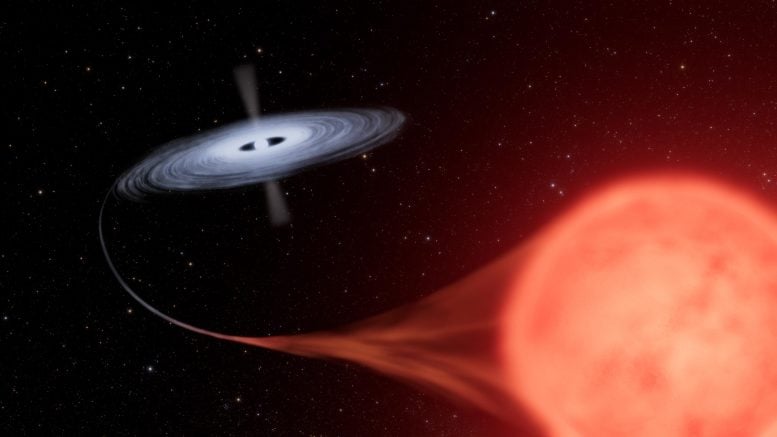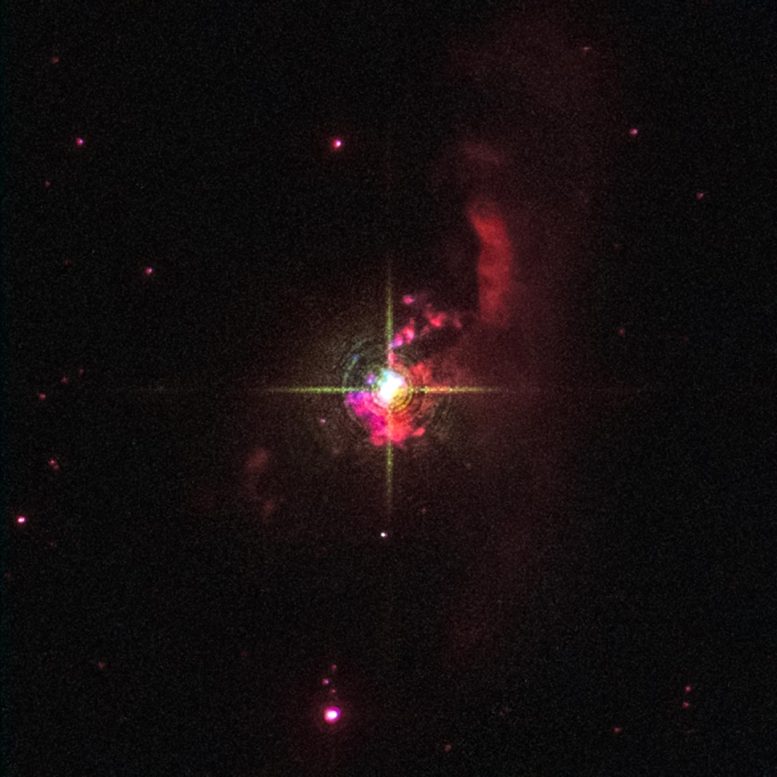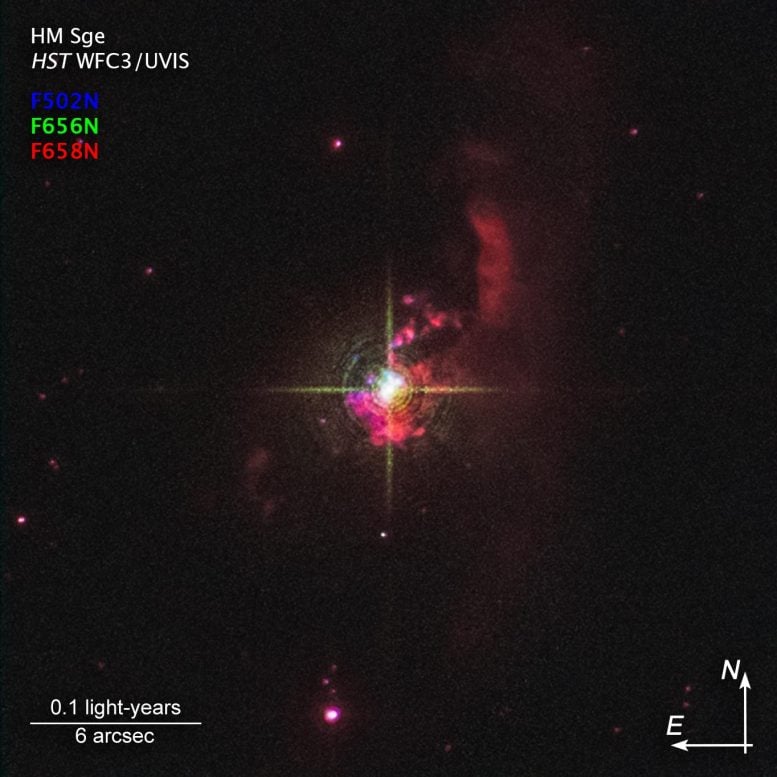
This artist’s concept shows the nova system HM Sagittae (HM Sge), where a white dwarf star is pulling material from its red giant companion. This forms a hot, blazing disk around the dwarf, which can unpredictably undergo a spontaneous thermonuclear explosion as the hydrogen inflow from the red giant thickens and reaches a tipping point. These interstellar flares are fascinating to astronomers, providing insights into the physics and dynamics of stellar evolution in binary systems. Credit: NASA, ESA, Leah Hustak (STScI)
The Hubble Telescope revisits a star system that is still extremely hot
If only we could look at the wonderful spiral structure of ours Milky Way galaxy from far above, and compressing millions of years into seconds, we would see short bursts of light, like the flashes from cameras showing at a stadium event. These are novae, where a burning star, a white dwarf, gas is swallowed by a spinning red giant companion. One of the strangest of these events occurred in 1975, when a nova called HM Sagittae grew 250 times brighter. It never really faded like novae usually do, but it has retained its luster for decades. Recent Hubble observations show that the system has grown hotter, but paradoxically it has dimmed a bit.

A Hubble Space Telescope image of the symbiotic star Mira HM Sge. Located 3,400 light-years away in the constellation Sagitta, it consists of a red giant and a white dwarf companion. The stars are too close together to be resolved by Hubble. Material flows from the red giant and falls on the dwarf, making it extremely bright. This system first ignited as a nova in 1975. The red nebula is evidence of the stellar wind. The nebula is about a quarter of a light year across. Credit: NASA, ESA, Ravi Sankrit (STScI), Steven Goldman (STScI), Joseph DePasquale (STScI)
The Hubble Space Telescope finds surprises about a star that exploded 40 years ago
Astronomers have revisited one of the strangest binary star systems in our galaxy – 40 years after it burst onto the scene as a bright, long-lived nova – using new data from NASAThe retired Hubble Space Telescope and SOFIA (Stratospheric Observatory for Infrared Astronomy), as well as archival data from other missions. A nova is a star that suddenly increases in brightness tremendously and then fades back to its former dimness, usually in a few months or years.
The unusual behavior of HM Sge
Between April and September 1975, the binary system HM Sagittae (HM Sge) grew 250 times brighter. Even more unusual, it didn’t die out as quickly as novae usually do, but retained its brightness for decades. Recently, observations show that the system has become hotter, but paradoxically it has faded a little.
HM Sge is a special type of symbiotic star where a white dwarf and a bloated, dust-producing giant companion star are in an eccentric orbit around each other, and the white dwarf swallows gas flowing from the giant star. That gas forms a hot, blazing disk around the white dwarf, which can unpredictably undergo a spontaneous thermonuclear explosion as the hydrogen fall from the giant thickens to the surface until it reaches a tipping point. These interstellar flares fascinate astronomers by providing insights into the physics and dynamics of stellar evolution in binary systems.
“When I first saw the new data, I went – ‘wow this is what Hubble UV spectroscopy can do!’ – I mean it’s spectacular, really spectacular.”
– Ravi Sankrit, Astronomer
Changes observed in 2021
“In 1975, HM Sge went from a nondescript star to something that every astronomer in the field was looking at, and at some point that flurry of activity slowed down,” said Ravi Sankrit of the Space Telescope Science Institute (STScI) in Baltimore. In 2021, STScI’s Steven Goldman, Sankrit and colleagues used instruments on Hubble and Sofia to see what had changed with HM Sge in the last 30 years in the wavelengths of light from infrared to ultraviolet (UV).
The 2021 ultraviolet data from Hubble showed a strong emission line of highly ionized magnesium that was not present in previously published spectra since 1990. Its presence indicates that the estimated temperature of the white dwarf and its disk accumulation increased from less than 400,000 degrees Fahrenheit in 1989 to more than 450,000 degrees Fahrenheit now. The highly ionized magnesium line is one of many firsts in the UV spectrum, which analyzed together will reveal the energy of the system and how it has changed over the last three decades.
“When I first saw the new data,” Sankrit said, “I went — ‘wow this is what Hubble UV spectroscopy can do!’ — I mean it’s spectacular, really spectacular.”

SOFIA flies over the snow-capped mountains of the Sierra Nevada with the telescope door open during a test flight. SOFIA is a modified Boeing 747SP aircraft. SOFIA achieved full operational capability in 2014 and completed its final science flight on September 29, 2022. Credit: NASA/Jim Ross
Data from SOFIA
With data from NASA’s SOFIA flyby telescope, which is set to retire in 2022, the team was able to detect the water, gas and dust flowing in and around the system. Infrared spectral data show that the giant star, which produces copious amounts of dust, returned to its normal behavior within just a few years of the explosion, but also that it has dimmed in recent years, another puzzle for explained to them.
With SOFIA, astronomers were able to see the water moving at about 18 miles per second, which they suspect is the speed of the accretion disk around the white dwarf. The gas bridge connecting the giant star to the white dwarf must currently stretch about 2 billion miles.
The team has also worked with AAVSO (American Association of Variable Star Observers), to collaborate with amateur astronomers from around the world who help maintain the telescope eyes on HM Sge; Their continued monitoring reveals changes not seen since its eruption 40 years ago.

A Hubble Space Telescope image of the symbiotic star Mira HM Sge with compass and scale bar. Located 3,400 light-years away in the constellation Sagitta, it consists of a red giant and a white dwarf companion. The stars are too close together to be resolved by Hubble. Material flows from the red giant and falls on the dwarf, making it extremely bright. This system first ignited as a nova in 1975. The red nebula is evidence of the stellar wind. The nebula is about a quarter of a light year across. Credit: NASA, ESA, Ravi Sankrit (STScI), Steven Goldman (STScI)
Rarity and Significance of HM Sge
“Symbiotic stars like HM Sge are rare in our galaxy, and witnessing a nova-like explosion is even rarer. This unique event is a treasure trove for astrophysicists that spans decades,” said Goldman.
Initial results from the team’s research were published in Astrophysical Journaland Sankrit is presenting research focused on UV spectroscopy at the 244th meeting of the American Astronomical Society in Madison, Wisconsin.
Reference: “A Multiwavelength Study of the Mira HM Sge Symbiosis with SOFIA and HST” by Steven R. Goldman, Ravi Sankrit, Edward Montiel, Sean Garner, Nathan Wolthuis, and Nicole Karnath, 11 January 2024, The Astrophysical Journal.
DOI: 10.3847/1538-4357/ad12c9
of Hubble Space Telescope has been operating for more than three decades and continues to make groundbreaking discoveries that shape our fundamental understanding of the universe. Hubble is an international collaborative project between NASA and ESA (European Space Agency). NASA’s Goddard Space Flight Center in Greenbelt, Maryland, manages the telescope and mission operations. Lockheed Martin Space, based in Denver, Colorado, also supports mission operations at Goddard. The Space Telescope Science Institute in Baltimore, Maryland, which is operated by the Association of Universities for Research in Astronomy, conducts Hubble science operations for NASA.